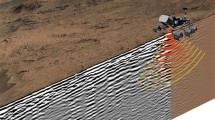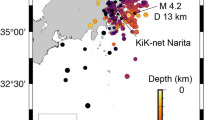Abstract
Three-dimensional (3D) ground-penetrating radar (GPR) systems and 3D seismic imaging techniques have been developing fast and evolving rapidly in the last decade. Ray-based migration methods have been successfully applied to processing 3D GPR signals based on the similarity between electromagnetic and seismic waves. However, reverse time migration (RTM) of 3D GPR signals has not been well studied in the past. In this paper, we present a 3D RTM based on Maxwell’s equations for 3D GPR surveys. Migration recovers the true subsurface structure from a distorted and unfocused time profile and suppresses common electromagnetic clutter and noise. RTM based on Maxwell’s equations can consider conductivity directly and compensate for the attenuation within a high-conductivity zone. Compared with 2D RTM, 3D RTM back-propagates both in-line and cross-line signals simultaneously and can include complex 3D permittivity and conductivity models. We have integrated a parallel finite-difference time-domain (FDTD) algorithm based on a hybrid MPI and OpenMP scheme to reduce the computational cost of 3D problems. The 3D RTM experiments on an anomaly of “EM” shape and a realistic sand dune model demonstrate the effective recovery of 3D subsurface structures.










Similar content being viewed by others
References
Baysal, E., Kosloff, D. D., & Sherwood, J. W. C. (1983). Reverse time migration. Geophysics, 48(11), 1514–1524.
Benson, A. K. (1995). Applications of ground penetrating radar in assessing some geological hazards: examples of groundwater contamination, faults, cavities. Journal of Applied Geophysics, 33(1), 177–193.
Biondi, B. (2007). Concepts and Applications in 3D Seismic Imaging. Society of Exploration Geophysicists and European Association of Geoscientists and Engineers.
Bourgeois, J. M., & Smith, G. S. (1996). A fully three-dimensional simulation of a ground-penetrating radar: FDTD theory compared with experiment. IEEE Transactions on Geoscience and Remote Sensing, 34(1), 36–44.
Bristow, C. S., Bailey, S. D., & Lancaster, N. (2000). The sedimentary structure of linear sand dunes. Nature, 406(6791), 56–59.
Bristow, C. S., Porat, N., Duller, G., Armitage, S. J., Roberts, H. M., Clarke, B. M., et al. (2003). Evidence for dune reactivation from GPR profiles on the Maputaland coastal plain, South Africa. Geological Society, London, Special Publications, 211, 29–46.
Claerbout, J. F. (1971). Toward a unified theory of reflector mapping. Geophysics, 36(3), 467–481.
Daniels, D. J. (2005). Ground Penetrating Radar. Hoboken: Wiley.
Ernst, J. R., Maurer, H., Green, A. G., & Holliger, K. (2007). Full-waveform inversion of crosshole radar data based on 2-D finite-difference time-domain solutions of Maxwell’s equations. IEEE Transactions on Geoscience and Remote Sensing, 45(9), 2807–2828.
Feng, X., Wang, Q., Lu, Q., Liu, C., Liang, W., Li, H., Yu, Y., Ren, Q. (July 2012). Subsurface imaging by modified migration for irregular GPR data. In: 2012 IEEE International Geoscience and Remote Sensing Symposium (IGARSS). pp. 3194–3197.
Fisher, E., McMechan, G. A., Annan, A. P., & Cosway, S. W. (1992). Examples of reverse-time migration of single-channel, ground-penetrating radar profiles. Geophysics, 57(4), 577–586.
Fu, L., Liu, S., Liu, L., & Wu, J. (2014). Airborne ground penetrating radar numerical simulation and reverse time migration. Chinese Journal of Geophysics-Chinese Edition, 57(5), 1636–1646.
Green, A., Gross, R., Holliger, K., Horstmeyer, H., & Baldwin, J. (2003). Results of 3-D georadar surveying and trenching the San Andreas fault near its northern landward limit. Tectonophysics, 368(1), 7–23.
Gross, R., Green, A., Horstmeyer, H., Holliger, K., & Baldwin, J. (2003). 3-D georadar images of an active fault: efficient data acquisition, processing and interpretation strategies. Subsurface Sensing Technologies and Applications, 4(1), 19–40.
Herrmann, F. J., & Hennenfent, G. (2008). Non-parametric seismic data recovery with curvelet frames. Geophysical Journal International, 173(1), 233–248.
Huang, Q., Li, Z., & Wang, Y. (2010). A parallel 3-D staggered grid pseudospectral time domain method for ground-penetrating radar wave simulation. Journal of Geophysical Research, 115(B12), B12101.
Jakubowicz, H., & Levin, S. (1983). A simple exact method of 3-D migration-theory. Geophysical Prospecting, 31(1), 34–56.
Jol, H. M. (2008). Ground penetrating radar theory and applications. Amsterdam: Elsevier.
Klokov, A., Sato, M. (July 2011). Application of 3-D migration algorithm to GPR on an irregular ground surface. In: 2011 IEEE International Geoscience and Remote Sensing Symposium (IGARSS). pp. 870–873.
Knight, R. (2001). Ground penetrating radar for environmental applications. Annual Review of Earth and Planetary Sciences, 29(1), 229–255.
Leuschen, C., & Plumb, R. (2001). A matched-filter-based reverse-time migration algorithm for ground-penetrating radar data. IEEE Transactions on Geoscience and Remote Sensing, 39(5), 929–936.
Levander, A. R. (1988). Fourth-order finite-difference P-SV seismograms. Geophysics, 53(11), 1425–1436.
Liu, S., Lei, L., Fu, L., & Wu, J. (2014). Application of pre-stack reverse time migration based on FWI velocity estimation to ground penetrating radar data. Journal of Applied Geophysics, 107, 1–7.
Loewenthal, D., Lu, L., Roberson, R., & Sherwood, J. (1976). The wave equation applied to migration. Geophysical Prospecting, 24(2), 380–399.
Mansour, H., Herrmann, F., & Yılmaz, O. (2013). Improved wavefield reconstruction from randomized sampling via weighted one-norm minimization. Geophysics, 78(5), V193–V206.
McClymont, A. F., Green, A. G., Villamor, P., Horstmeyer, H., Grass, C., & Nobes, D. C. (2008). Characterization of the shallow structures of active fault zones using 3-D ground-penetrating radar data. Journal of Geophysical Research, 113(B10), B10315.
McMechan, G. A. (1983). Migration by extrapolation of time-dependent boundary values. Geophysical Prospecting, 31(3), 413–420.
Meles, G. A., Van Der Kruk, J., Greenhalgh, S. A., Ernst, J. R., Maurer, H., & Green, A. G. (2010). A new vector waveform inversion algorithm for simultaneous updating of conductivity and permittivity parameters from combination crosshole/borehole-to- surface GPR data. IEEE Transactions on Geoscience and Remote Sensing, 48(9), 3391–3407.
Moran, M. L., Greenfield, R. J., Arcone, S. A., & Delaney, A. J. (2000). Multidimensional GPR array processing using Kirchhoff migration. Journal of Applied Geophysics, 43(2), 281–295.
Naghizadeh, M., & Sacchi, M. (2010). Beyond alias hierarchical scale curvelet interpolation of regularly and irregularly sampled seismic data. Geophysics, 75(6), WB189–WB202.
Neal, A. (2004). Ground-penetrating radar and its use in sedimentology: principles, problems and progress. Earth-Science Reviews, 66(3–4), 261–330.
Olhoeft, G. R. (1998). Electrical, magnetic, and geometric properties that determine ground penetrating radar performance. In: Proceedings of GPR ‘98, Seventh International Conference on Ground Penetrating Radar. University of Kansas, Lawrence, KS. Vol. 98. pp. 177–182.
Qian, R., & Liu, L. (2016). Internal structure of sand dunes in the Badain Jaran desert revealed by GPR. IEEE Journal of Selected Topics in Applied Earth Observations and Remote Sensing, 9(1), 159–166.
Radzevicius, S. (2008). Practical 3-D migration and visualization for accurate imaging of complex geometries with GPR. Journal of Environmental & Engineering Geophysics, 13(2), 99–112.
Roden, J. A., & Gedney, S. D. (2000). Convolutional PML (CPML): an efficient FDTD implementation of the CFS-PML for arbitrary media. Microwave and Optical Technology Letters, 27(5), 334–338.
Song, J., Liu, Q. H., Torrione, P., & Collins, L. (2006). Two-dimensional and three-dimensional NUFFT migration method for landmine detection using ground-penetrating radar. IEEE Transactions on Geoscience and Remote Sensing, 44(6), 1462–1469.
Su, M., El-Kady, I., Bader, D., Lin, S. (Aug 2004). A novel FDTD application featuring OpenMP-MPI hybrid parallelization. In: ICPP 2004 International Conference on Parallel Processing. Vol. 1. pp. 373–379.
Whitmore, N. D. (1983). Iterative depth migration by backward time propagation. SEG Technical Program Expanded Abstracts, 1983, 382–385.
Yang, X., Klotzsche, A., Meles, G., Vereecken, H., & Van Der Kruk, J. (2013). Improvements in crosshole GPR full-waveform inversion and application on data measured at the Boise hydrogeophysics research site. Journal of Applied Geophysics, 99, 114–124.
Yoon, K., Shin, C., Suh, S., Lines, L. R., & Hong, S. (2003). 3D reverse-time migration using the acoustic wave equation: an experience with the SEG/EAGE data set. The Leading Edge, 22(1), 38–41.
Zhu, T., Harris, J., & Biondi, B. (2014). Q-compensated reverse-time migration. Geophysics, 79(3), S77–S87.
Zhu, W., & Huang, Q. (2016). Attenuation compensated reverse time migration method of ground penetrating radar signals. Chinese Journal of Geophysics, 59(10), 3909.
Acknowledgements
This work is supported by the National Science Foundation of China (41574104, 41874082). The calculations were performed on a Tianhe-1(A) supercomputer. We are grateful to the three anonymous reviewers for their excellent reviews and constructive suggestions.
Author information
Authors and Affiliations
Corresponding author
Additional information
Publisher's Note
Springer Nature remains neutral with regard to jurisdictional claims in published maps and institutional affiliations.
Appendix A. Hybrid MPI & OpenMP
Appendix A. Hybrid MPI & OpenMP
This appendix shows the program structure of parallel FDTD (Fig. 11) and the pseudo-code of the hybrid MPI & OpenMP scheme (Fig. 12) inside each subdomain of Fig. 11. The entire FDTD domain is divided into several subdomains, and each subdomain is distributed to one processor. A hybrid parallelization scheme with both OpenMP and MPI (Su et al. 2004) is used here. MPI is used for communication between nodes, and OpenMP is used to carry out multi-threading parallel computing on a single shared-memory node. Combining MPI and OpenMP makes FDTD fully utilize the power of parallel systems constructed out of interconnected symmetric multiprocessing (SMP) nodes.
Structure of the parallel FDTD algorithm. The code consists of three parts: (1) Input parameters and settings for each subdomain, which include “eps” (model of dielectric permittivity), “mu” (model of magnetic permeability), “sig” (model of electric conductivity), “src” (positions of sources and input signals), “rec” (positions of receivers), etc. (2) The main part for parallel FDTD simulation. The whole computational domain is divided into several subdomains. For each subdomain, E&H components are updated using OpenMP. For each time step, the values on edges of each domain are exchanged through MPI. (3) Output of the recorded gathers, slices, and wavefields during propagation
Rights and permissions
About this article
Cite this article
Zhu, W., Huang, Q., Liu, L. et al. Three-Dimensional Reverse Time Migration of Ground-Penetrating Radar Signals. Pure Appl. Geophys. 177, 853–865 (2020). https://doi.org/10.1007/s00024-019-02341-x
Received:
Revised:
Accepted:
Published:
Issue Date:
DOI: https://doi.org/10.1007/s00024-019-02341-x






